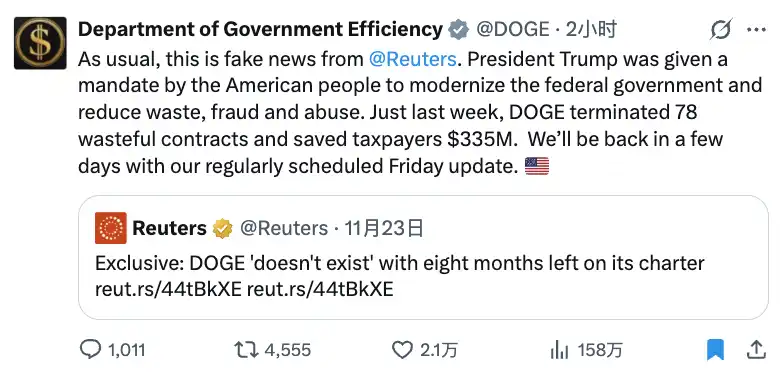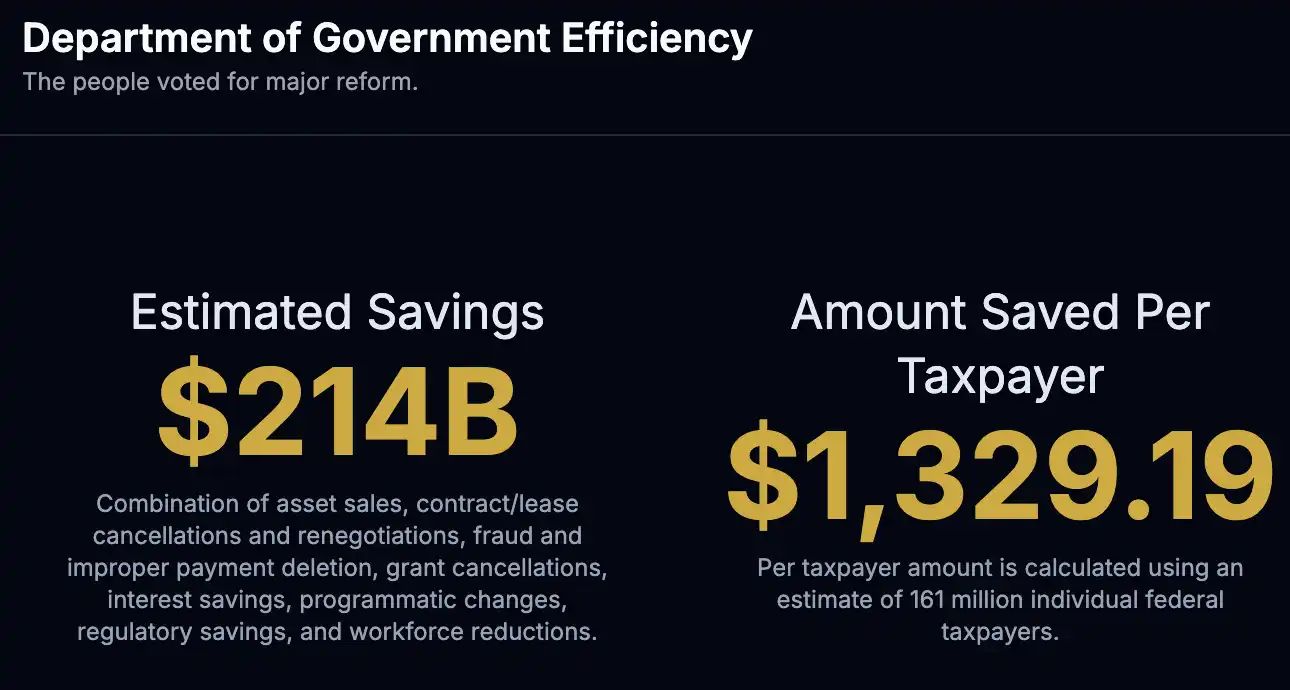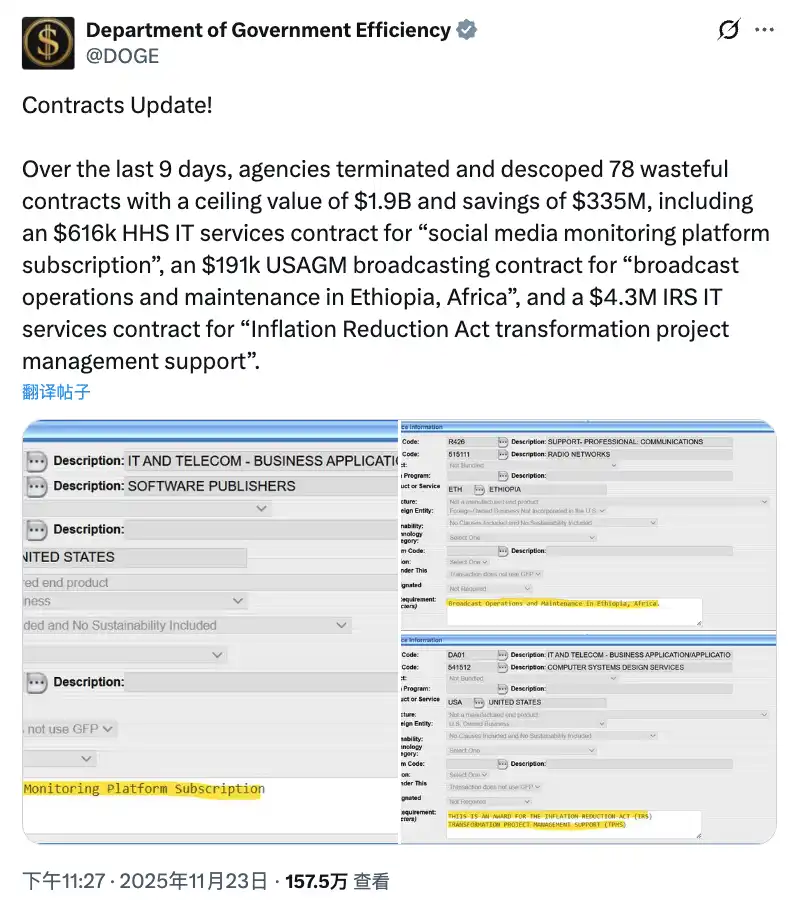The news reported by Reuters that "the U.S. government's efficiency department DOGE has been disbanded" turned out to be fake news.
According to a Reuters report on November 23, the person who publicly confirmed this news was Scott Kupor, the director of the U.S. Office of Personnel Management (USOPM) under the Trump administration. This news quickly caused a stir. In Reuters' description, DOGE's gradual decline stands in stark contrast to the government's months-long promotion of its effectiveness: Trump and his advisors, along with cabinet ministers, initially hyped it on social media, and Musk even once wielded a chainsaw to promote his cuts to government positions.
However, a dramatic scene soon unfolded, as this seemingly explosive report quickly sparked controversy and multiple clarifications.

DOGE tweeted that this is fake news
After the report was published, Scott Kupor, the person who supposedly confirmed the news, quickly disputed Reuters on social media, stating that Reuters had "cleverly edited" his full comments to create a sensational headline.
He clarified in a tweet: "The principles of DOGE still exist and are functioning well: deregulation, eliminating fraud waste and abuse, reshaping the federal workforce, and making efficiency a top priority. DOGE has catalyzed these changes." He added, "The fact is: DOGE may not have achieved centralized leadership under @USDS. But the principles of DOGE still exist and are effective."

Reuters' "Fake News," Those Hoping for DOGE's Dissolution Never Rest
As a globally renowned news agency, Reuters has clients all over the world and should theoretically maintain a relatively neutral stance. However, in the U.S., conservative readers generally perceive Reuters as left-leaning. This premature report on DOGE's dissolution raises questions about whether it was an objective statement of fact or carried some bias. There is much debate on this matter.
Various signs suggest that this report may reflect several layers of sentiment: first, the establishment and traditional media are fundamentally displeased with DOGE as a disruptor and want to diminish its influence by exaggerating its "dissolution"; second, the Washington political circle has always been averse to Musk and DOGE, and this was a convenient opportunity to declare its failure through the media.
Public speculation is not without basis.
Since its inception, DOGE has been destined to make enemies on all sides. The very existence of this agency challenges the power structure in Washington, touching too many people's interests, and thus it has faced fierce opposition from multiple fronts.
Protesters gathered outside the Office of Personnel Management, claiming that Musk illegally controlled government infrastructure and expressing concerns that this unelected foreign-born individual might steal sensitive information stored on federal servers. Federal employees, retirees, and others shocked and angered by Musk and DOGE's actions organized rallies in front of the Treasury Department. Twenty-one employees of the U.S. Digital Service (USDS) collectively resigned. These internal rebellions demonstrate that DOGE's radical approach has provoked strong resistance from government employees.
Multiple polls indicate that most Americans oppose DOGE's dissection of the government and the power Musk has gained. Musk once stated in a cabinet meeting that the government efficiency department team he led was receiving death threats daily.

Despite Musk leaving Washington after publicly falling out with Trump in May, Trump administration officials have never publicly claimed that DOGE no longer exists. However, signals of DOGE's demise have been discussed and released externally.
For instance, the "misleading informant" Scott Kupor, although there is no direct evidence indicating he has had a public conflict with Musk or DOGE, has previously expressed his disagreement with DOGE's handling methods.
Who is the "Misleading Informant" Scott Kupor?
The name Scott Kupor may be unfamiliar to many. He was previously a managing partner at the well-known Silicon Valley venture capital firm Andreessen Horowitz (a16z). On July 14, 2025, Scott Kupor was sworn in as the director of the U.S. Office of Personnel Management.
After taking office, Kupor introduced modern recruitment reforms, such as changing the traditional "select one from three candidates" to "select from a larger talent pool," aiming to choose from a broader talent pool. He also emphasized that OPM should become more efficient and transparent, actively bringing in technical talent (especially related to AI) into the federal government.
In media interviews, Kupor has made it clear: "OPM is its own agency." He added that if DOGE's goals align with his, he is willing to cooperate, but he will never fully follow DOGE's directives. In other words, he wants to institutionalize efficiency reforms but will not fully adopt Musk's radical methods.
Past reports also indicate that Kupor and DOGE have differing opinions. According to the Financial Times, he has criticized the control mechanisms pushed by Musk, such as requiring employees to submit "weekly progress reports." The Washington Post also reported that he found Musk's "5 Things Weekly Report System" inefficient. Regarding Musk's initially proposed super radical reduction targets, he expressed skepticism: "We can't just save $2 trillion by cutting discretionary spending to zero."
This gradual reform approach sharply contrasts with Musk's radical layoffs. Kupor may believe that promoting reform through a traditional agency like OPM is more prudent and sustainable than relying on an "external consultant" like Musk. Despite criticism, he also acknowledges that DOGE has played a key catalytic role.
According to Kupor himself, along with Reuters' revelations, OPM has now taken over many of DOGE's cost-cutting and personnel reduction tasks. From a bureaucratic perspective, OPM, as the federal government's human resources department, is supposed to handle these tasks. Kupor's statements may reflect an internal adjustment within the Trump administration: no longer needing a controversial independent agency led by Musk, but rather integrating reform functions into regular government departments. This way, they can continue to push for reform while reducing external pressure.
What "Report Card" Has DOGE Delivered?
In October last year, at a Trump campaign rally at Madison Square Garden, Musk stated that he believed DOGE could cut "at least" $2 trillion in federal spending, a figure higher than the discretionary spending budget for 2023.
In the first cabinet meeting this February, Musk remained optimistic that he could cut $1 trillion—15% of the budget.
However, as time went on, this target was repeatedly scaled back. By April 2025, Musk stated that $150 billion had been cut, but this figure was questioned by fact-checkers, and Blake Moore, the head of the House DOGE core group, stated on June 5 that Republican members had always known this was "a massive exaggeration."
According to its website, DOGE terminated 13,440 contracts, 15,887 grants, and 264 leases—these estimated figures fluctuated dramatically during its 10 months of existence. DOGE promised to save American taxpayers $1 trillion, but even according to their own accounts, they have fallen far short of this goal.
As of the time of writing, the DOGE website claims that the department has collectively achieved $214 billion in savings through "asset sales, contract/lease cancellations and renegotiations, fraud and improper payment eliminations, grant cancellations, interest savings, project changes, regulatory savings, and layoffs," equivalent to $1,329.19 per taxpayer.

This figure is far from the initially promised $1 trillion target, achieving only about 21%. Since the agency has not disclosed detailed work accounts, external financial experts cannot verify the authenticity of this claim. After the fiscal year ended in October, The New York Times reported that budget experts and the congressional appropriations committee still did not know how much funding had been cut or where these unused funds had gone.
In a recent tweet, DOGE stated that in the past nine days, it has terminated or reduced 78 wasteful contracts, with a total value of $1.9 billion, saving $335 million.

These include a $616,000 HHS IT services contract for "social media monitoring platform subscriptions"; a $191,000 USAGM broadcasting contract for "broadcast operations and maintenance in Ethiopia, Africa"; and a $4.3 million IRS IT services contract for "Inflation Reduction Act transformation project management support."
Prior to this, DOGE's "achievements" were primarily reflected in personnel reductions and paralyzed agencies.
DOGE began its federal agency cuts by eliminating all employees engaged in diversity, equity, and inclusion work across federal agencies, who were placed on administrative leave.
Then, DOGE announced a voluntary "deferred retirement" plan, also known as "Fork in the Road," offering federal employees the option to resign while continuing to receive pay until the end of September—nearly 75,000 federal employees accepted this proposal in February. Related reading: "Cutting hundreds of millions in contracts, what quirky government departments has Musk's D.O.G.E. discovered?"
The second Trump administration announced approximately 300,000 layoffs of U.S. federal employees, almost all attributed to DOGE. As of July 14, 2025, CNN tracked at least 128,709 workers who were laid off or targeted for layoffs. As of May 12, The New York Times tracked over 58,500 confirmed cuts, over 76,000 employee buyouts, and over 149,000 other planned cuts; the total cuts accounted for 12% of the 2.4 million civilian federal workforce.
In a blog post released on Friday regarding the federal personnel plan, Kupor stated that the government hired about 68,000 people this year, while 317,000 employees left the government—exceeding Trump's goal of cutting four employees for every one hired.
Specifically, in various departments: the Department of Education will cut nearly 50% of its staff. Over 1,300 positions will be eliminated through RIF—along with about 600 people accepting the "Fork" deferred resignation proposal or the department's VSIP proposal. The Department of Veterans Affairs aims to "return to our final strength of 399,957 employees in 2019," which will reduce about 80,000 employees. The Department of Health and Human Services announced significant cuts, stating it intends to cut 20,000 positions (25% of the agency), half of which they plan to achieve through early retirement, buyouts, and natural attrition.
DOGE has also been a driving force behind many personnel cuts within the federal government this year. Government agencies account for most of these layoffs, with 62,530 federal employees laid off in the first two months of 2025. This is an astonishing increase of 41,311 compared to the same period in 2024.
It is no wonder that this fake news about DOGE's "dissolution" has emerged, as too many people hope to see this agency that disrupts the power dynamics in Washington disappear.
And now, the story of DOGE may not be truly over yet.
免责声明:本文章仅代表作者个人观点,不代表本平台的立场和观点。本文章仅供信息分享,不构成对任何人的任何投资建议。用户与作者之间的任何争议,与本平台无关。如网页中刊载的文章或图片涉及侵权,请提供相关的权利证明和身份证明发送邮件到support@aicoin.com,本平台相关工作人员将会进行核查。




